|
Dumuzi
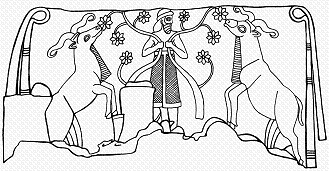
Aliases: Tammuz, Damu, Ta'uz, Tamoza
Location: Mesopotamia (Iraq), Canaan (Palestine)
Cities: Bad-Tibira, Kuara, Uruk, Harran, Byblos, Bethlehem
Estimated Date: 2500s B.C. - 900s A.D.
His name means “True Son”, “Faithful Son”, “Living Son”, or “Risen Son”
“Dumu” means “son” and “Zi” means “true”, “faithful”, or “living” or “risen”.
He is a shepherd and a fisherman
Dumuzi is referred in myth as “the Shepherd,” just as Jesus is the “Good Shepherd”. The Sumerian king list refers to one Dumuzi as “the Shepherd” and another as “the Fisherman,” a symbol also used for Jesus’ disciples, who are described as fishermen who were then called by Jesus to become “fishers of men”.
His wife is associated with Venus, which is linked to an early falling/dying god that Jerusalem is named after
Dumuzi’s wife Inanna, whose name means "Lady of Heaven", is identified with the planet Venus, whose astral movements are symbolized in myth by Inanna’s death and resurrection. Inanna tries to take over the queen-dom of the dead from her sister Ereshkigal, removing more and more of her regalia in order to pass through seven gates to the underworld, symbolizing the descent of Venus losing its radiance. Ereshkigal kills Inanna and hangs her on a stake but Dumuzi’s father, the Promethean god Enki resurrects her, allowing her rise back up, connecting the falling “evening star” with the rising “morning star”. A related Canaanite myth describes morning and evening star aspects of Venus in the form of two male gods: Shahar, the god of the dawn, and Shalim, the god of the dusk, the twin sons of Inanna’s Canaanite equivalent, Asherah. Shalim is the original god that Jerusalem (Yeru-shalem) is named after and his twin brother Shahar, the same god referenced in a famous passage from the Book of Isaiah as the father of Hel-El (“day-god”), but was translated in the Latin as “Lucifer”: “How art thou fallen from heaven, O Lucifer, son of the morning (Helel, son of Shahar)! how art thou cut down to the ground, which didst weaken the nations!” (14:12 KJV).
One of them sprinkled on it the life-giving plant and the other the life-giving water. And thus Inana arose.
He is attacked while under a great apple tree, just as Jesus was said to have been crucified on the Tree of Life in Eden
After Enki resurrects Inanna, she is forced by the demons of her sister Ereshkigal to choose a replacement for the underworld and because her husband failed to mourn for her death, she picks Dumuzi as he sat under “the great apple tree in the plain of Kaluba” (in Uruk, in Southern Iraq), bringing to mind the tree of wisdom in the garden of Eden. The vegetation god calls out to the sun god to save him, and Utu changes Dumuzi into an animal several times to escape the demons, but they eventually catch and kill him. Interestingly, Jesus was said to have been “hung on a tree” in Galatians 3:13 and 1 Peter 2:24. Acts 5:30, 10:39, and 13:29 also uses the term “tree” instead of “cross” when Peter, Paul or the apostles are explaining how Jesus died, but not when the author wrote about it, as if trying to explain how that term “tree” came to be used instead of “cross”. The anti-gospel known as the Toledot Yeshu also portrays Jesus as being stoned to death in the first century B.C. and then hung on a cabbage stalk because Jesus had cursed the trees so that none would hold his body. Mara Bar Serapion and the Talmud corroborates the story of Jesus being executed in the first century B.C. by Jewish elders, not by Romans, just as 1 Thessalonians 2:14-15 also puts full blame on “the Jews” without any mention of the Romans. Likewise, Galatians 3:13 says Jesus was hung on a tree according to a Jewish law from the Book of Deuteronomy. However, the earliest reference to Jesus’ death in the epistles probably comes from 1 Corinthians 2:6, in which Jesus is said to have been killed by the archons of this aeon, the “powers of this age/realm/plane”, which can mean either mortal rulers or elemental demons. Only in the late second century epistle 1 Timothy does Jesus get crucified by Pontius Pilate. Revelation 2:7 and 22:2 use the Tree of Life as a symbol of messianic salvation. The third century theologian Origen said, “Scripture describes Christ as a tree.” A third century Christian poem by Pseudo-Cyprian and the fourth century bishop Cyril of Jerusalem associated the cross to the Tree of Life in the middle of the world.

Dumuzi attacked by demons under the great apple tree of Kaluba
They followed her to the great apple tree in the plain of Kulaba. There was Dumuzid clothed in a magnificent garment and seated magnificently on a throne. The demons seized him there by his thighs.
....
Holy Inana wept bitterly for her husband.
[4 lines fragmentary]
She tore at her hair like esparto grass, she ripped it out like esparto grass. "You wives who lie in your men's embrace, where is my precious husband? You children who lie in your men's embrace, where is my precious child? Where is my man? Where ......? Where is my man? Where ......?"
When the fifth entered the sheepfold and cow-pen, the churns lay on their side, no milk was poured, the drinking cups lay on their side, Dumuzid was dead, the sheepfold was haunted.
He spends Winter with the Queen of the netherworld and Spring with the fertility goddess
Dumuzi is resurrected after which half the year the vegetation god goes into the underworld (winter) and half the year his sister will take his place (summer).
“You for half the year and your sister for half the year: when you are demanded, on that day you will stay, when your sister is demanded, on that day you will be released.”
The festival of his death is at the same time as the Jewish Festival of the Booths and the festival of his resurrection is marked by his name on the Hebrew calendar
The Festival of the Booths was instituted by Moses in the Bible to commemerate the wandering in the desert by building makeshift booths and living in them. Like this festival, the festival of Tammuz also involved a water-drawing but also included mourning for his death that ended in ecstatic dancing. The Mishnah and Talmud describe continued festivities in which men and women intermingled and became “ligthheaded”, which continued until the fall of Jerusalem in 70 A.D. Tammuz's resurrection festival was celebrated in the the fourth month of the Babylonian/Assyrian calendar, the day of the first new moon of the Summer Solstice. The name of the month was itself named Tammuz, a name was adopted into the Hebrew and Assyrian Christian calendars.
He is resurrected by women ritually mourning his death
In a very similar Akkadian text, Tammuz’s sister Belili (Gesthinanna) calls for the women to weep for Tammuz in order to resurrect him.
When Belili heard the lament of her brother, she dropped her treasure,
She scattered the precious stones before her,
"Oh, my only brother, do not let me perish!
On the day when Tammuz plays for me on the flute of lapis lazuli, playing it for me with the porphyry ring.
Together with him, play ye for me, ye weepers and lamenting women!
That the dead may rise up and inhale the incense."
He is resurrected from beneath the Tree of Life

Mesopotamian cylinder seal dated 2320-2150 B.C.
(S. Beaulieu, after Wolkstein and Kramer 1983:40)
A goddess associated with his wife is worshipped using a sacramental tree pole
In Canaan and Asia Minor, a gooddess named Asherah, which some scholars link with Tammuz's wife Ishtar, was worshipped in sacred groves using wooden tree poles that were named after her.
I will drive out before you the Amorites, Canaanites, Hittites, Perizzites, Hivites and Jebusites. Be careful not to make a treaty with those who live in the land where you are going, or they will be a snare among you. Break down their altars, smash their sacred stones and cut down their Asherah poles.
He has a sacramental ritual of bread and water (not wine, though his sister is named after wine)
A sacramental meal of bread and water seems to play some role in Dumuzi’s ritual, prefiguring the later bread and wine sacrament of the Eucharist. The wine element, however, is not completely absent since the name of Dumuzi’s sister, Geshtinanna, means “Wine of Heaven”. In the Sumerian myth where Enki resurrects Inanna, he sends two servants that resurrect her with the “plant” and “water” of life.
Dumuzi spoke:
"My sister, I would go with you to my garden.
Inanna, I would go with you to my garden.
I would go with you to my orchard.
I would go with you to my apple tree.
There I would plant the sweet, honey-covered seed."
Dumuzi sang:
....
Water flows from on high for your servant.
Bread flows from on high for your servant.
Pour it out for me, Inanna.
I will drink all you offer."
His father created Eden, ate a “forbidden fruit”, was healed by a Rib Goddess, created man out of clay, and gave Dumuzi's wife the “Knowledge of Good and Evil”
Dumuzi’s father, the wise god Enki, in a myth not mentioning Dumuzi, fathers several goddesses in an ageless, deathless garden where freshwater flows from the ground and childbirth is easy and pain-free, just like Eden. The Sumerian verse, “The lion did not slay, the wolf was not carrying off lambs”, echoes the famous Golden Age language used in Isaiah 11:6, “The wolf will live with the lamb, the leopard will lie down with the goat, the calf and the lion and the yearling together; and a little child will lead them.” The Sumerian golden age is ruined when Enki eats some forbidden plants that the birth-giving goddess Ninhursag grew, echoing the “forbidden fruit” motif of the Eden story. Ninhursag curses Enki and he becomes sick but she later relents and gives birth to eight goddess to heal eight of his body parts, one of these goddesses being the “Lady of the Rib,” which in Sumerian also means “Lady of Life”, an association that explains why Eve was made from Adam’s rib despite the fact there is no etymological relationship between the two words in Hebrew. Just as Yahweh creates Adam out of the dust of the ground, Enki tells his sea goddess mother, Nammu, to create humans out of clay and then give birth to them with the help of Ninhursag. This is paralleled by the Greek titan Prometheus, who also forms man out of clay and rebels against Zeus by providing man with fire, which ultimately causes Zeus to produce the first woman, Pandora, who through her curiosity unleashes all the evils upon the world, either by two urns of good and evil (parallel to the fruit of knowledge of good and evil) or, in a different myth, by a large jar of world’s evil that nevertheless leaves hope behind. Like Satan, Prometheus is eternally tortured by Zeus for his “hubris,” not by hellfire, but by having vultures eat his ever-regenerating liver. This destructive knowledge that brought civilization is paralleled by another Sumerian myth that Inanna got Enki drunk and convinced him to allow her to take the secret culutral arts from his temple in Eridu to her temple in Kulaba (Uruk).
Virginal is Dilmun land. Pristine is Dilmun land…
In Dilmun the raven was not yet cawing, the partridge not cackling. The lion did not slay, the wolf was not carrying off lambs, the dog had not been taught to make kids curl up, the pig had not learned that grain was to be eaten. When a widow has spread malt on the roof, the birds did not yet eat that malt up there. The pigeon then did not tuck the head under its wing. No eye-diseases said there: "I am the eye disease." No headache said there: "I am the headache." No old woman belonging to it said there: "I am an old woman." No old man belonging to it said there: "I am an old man."....
At that moment, on that day, and under that sun, when Utu stepped up into heaven, from the standing vessels (?) on Ezen's (?) shore, from Nanna's radiant high temple, from the mouth of the waters running underground, fresh waters ran out of the ground for her....
[Ninhursag’s] nine months were nine days. In the month of womanhood, like fine (?) oil, like fine (?) oil, like oil of abundance, Nintur [Ninhursag], mother of the country, like fine (?) oil, gave birth to Ninnisig....
[Ninhursag asked:] "My brother, what part of you hurts you?" "My ribs [ti] hurt me." She gave birth to Ninti [Lady of the Rib/Life] out of it.
At the time when Yahweh God made earth and heaven there was as yet no wild bush on the earth nor had any wild plant yet sprung up, for Yahweh God had not sent rain on the earth, nor was there any man to till the soil. Instead, water flowed out of the ground and watered all the surface of the soil…
To the woman he said: I shall give you intense pain in childbearing, you will give birth to your children in pain.
And after Enki, the fashioner of designs by himself, had pondered the matter, he said to his mother Namma: "My mother, the creature you planned will really come into existence. Impose on him the work of carrying baskets. You should knead clay from the top of the abzu; the birth-goddesses (?) will nip off the clay and you shall bring the form into existence. Let Ninmaḫ act as your assistant; and let Ninimma, Šu-zi-ana, Ninmada, Ninbarag, Ninmug, …… and Ninguna stand by as you give birth.
This is also something that Aesop said. The clay which Prometheus used when he fashioned man was not mixed with water but with tears. Therefore, one should not try to dispense entirely with tears, since they are inevitable.
There are two urns (pithoi) that stand on the door-sill of Zeus. They are unlike for the gifts they bestow: an urn of evils (kakoi), an urn of blessings (dôroi)"
But the woman took off the great lid of the jar (pithos) with her hands and scattered all these and her thought caused sorrow and mischief to men. Only Hope (Elpis) remained...
His father had the ark of the great flood built
When the ruling gods An and Enlil decide to flood the earth, it is the rebellious Enki who provides the secret to the ark-builder, Ziusudra. The Sumerian deluge story includes saving all of the animals, the opening of the ark window (by Utu, the sun god), and the animal sacrifice just as in the Genesis story. The Babylonian version includes the releasing of the raven.
Adam must sympathize with his death in order to enter heaven
The Assyrian version of Adam, called Adapa, was a fisherman priest of Ea (Enki) who died at sea to find that Heaven’s gate guarded a ‘la St. Peter by Dumuzi and a similar god, Gizzida (literally “Good Tree”). Adapa must mourn for the death of the two gods in order to be presented in a good light towards the Father god, Anu (lit. “Heaven”). This motif is somewhat similar to the way sympathizing with the death of Jesus is crucial to getting into heaven in the Pauline epistles. When Adapa meets Anu, he is offered the bread and water of eternal life, but follows the advice of Ea, he misses his chance at eternal life, similar to the story of how Adam missed his chance to eat from the Tree of Life in Genesis. The rest of the story has been damaged, but from some of the garbled remains, there also appears to be a disaster which is probably a correlation to the hardships of the “Fall of Man” in Genesis.
Ea [Enki], aware of heaven's ways, touched him and . . . made him wear his hair unkempt, clothed him in mourning garb, gave him instructions, "Adapa, you are to go before king Anu. You will go up to heaven, And when you go up to heaven, When you approach the Gate of Anu, Dumuzi and Gizzida will be standing in the Gate of Anu, Will see you, will keep asking you questions 'Young man, on whose behalf do you look like this? On whose behalf do you wear mourning garb?' [You must answer] ’Two gods have vanished from our country and that is why I am behaving like this.’ [They will ask] 'Who are the two gods that have vanished from the country?' (You must answer) 'They are Dumuzi and Gizzida.' They will look at each other and laugh a lot. [They] will speak a word in your favor to Anu. [They] will present you to Anu in a good mood.”
He is associated with the serpent and his companion is symbolized by a serpent pole that was also used for healing by Moses and referenced by Jesus as a symbol of resurrection
Both Dumuzi and Inanna carry a title, “Great Mother Dragon of Heaven", probably inherited from Dumuzi's grandmother, the mother of all the gods, Nammu. In Babylonian mythology, she is a great chaos beast that the storm/war god Marduk must slay. The Sumerian storm/war god Ninurta also fights a seven-headed “Warrior Dragon”. The Canaanite storm/war god likewise fights a multi-headed sea dragon named Lotan, called Leviathan in the Bible. Even before the Sumerian age, the Ubaid period of Mesoptamia between 6500 and 3800 B.C. shows that the totem animal of the gods were serpentine instead of the later Sumerian and Canaanite bull totem, represented by the golden calf. The Dumuzi-like god Ningishzida, the companion of Dumuzi called Gizzida in the Myth of Adapa, is represented on a Neo-Sumerian vase dated to the 2000s B.C. as a caduceus, the ancient healing symbol of a serpent wrapped around a tree that still shown on ambulances. In Exodus 15:22-16:1, Moses uses a bronze pole shaped like a cadeucus, called Nehushtan, most likely representing an Asherah pole, in order to heal the Israelites from “fiery serpents”. The Second Book of Kings says it was later destroyed by king Hezekiah because Israelite were burning incense to it. There is some question as to what the “fiery serpents” mentioned in Exodus were. One hypothesis is that they represented parasitical Guinea worms that lodge under the skin and can be cured by slowly pulling the worm out with a stick, a process that looks somewhat similar to the serpent wrapped around the tree. According to the Hebrew scholar Grey Hubert Skipworth, the Levite priesthood that claimed descent from Moses may also have been associated with the serpent given the root word of their name, Levi, meaning “coiled” or “joined”, is the same as that of Leviathan (“coiled serpent”). John 3:14 equates Jesus with Moses' bronze serpent, saying both needed to be lifted up, and the fourth century archbishop John Chrysostom links Jesus directly with the serpent. The Greek Orthodox Church continues to celebrate the Feast of the Elevation of the Holy Cross by reading from that Exodus verse, which is associated with both the Tree of Life and the Cross of Jesus.
“Just as Moses lifted up the snake in the wilderness, so the Son of Man must be lifted up, that everyone who believes may have eternal life in him.”
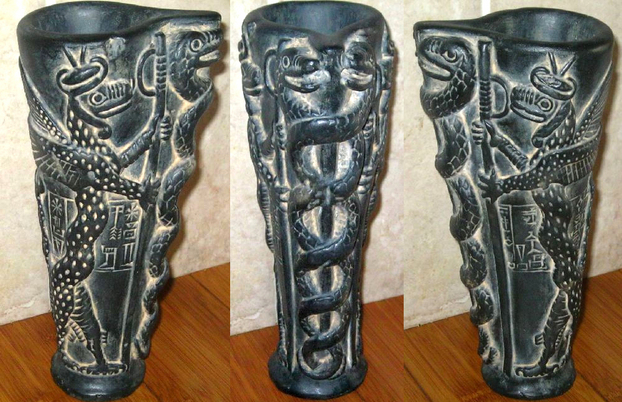
Gudea vase dedicated to Ningishzida, dated to 2000s B.C.
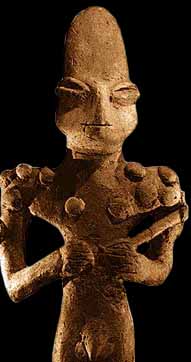
Eridu serpent god dated to 5000s B.C.
He carries an ivy wand topped with a pine cone just as Jesus is depicted using a wand to enact miracles
Tammuz is depicted carrying a thyrsus, a staff or wand with ivy and a pine cone on the end, identical to one carried by Dionysus. The use of a wand is somewhat similar to multiple depictions of Jesus raising Lazarus or turning water into wine using an augur's wand that was common among the Roman priestly class.
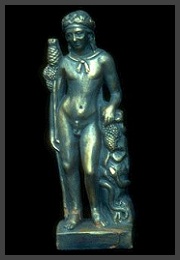 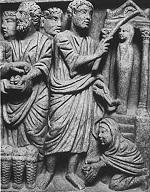
Tammuz and Jesus with wands
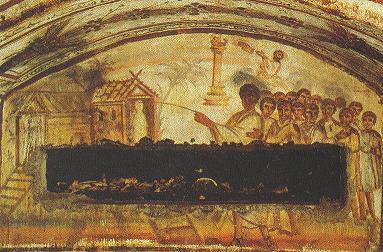 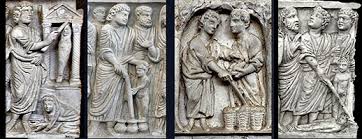
Jesus doing miracles with a wand, dated to 300s - 400s A.D.
One of his sex poems became a book in the Bible
The Song of Solomon, also known as the Song of Songs or the Canticle of Canticles, is based on the sacred marriage love poetry of Dumuzi and Inanna. Dumuzi and Inanna have sex against an apple tree in a garden, mirroring the sexual overtones in the Eden story.
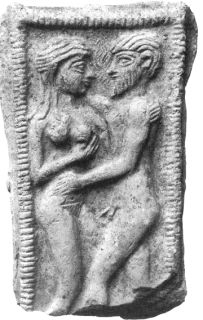
He was ritually mourned at the Jerusalem Temple by the women of the city
He next took me to the entrance of the north gate of the Temple of Yahweh where women were sitting, weeping for Tammuz.
The Tau cross was used to designate adherence to Yahweh instead of him
Strangely enough, after complaining about the fact that the women of Jerusalem were weeping for Tammuz at the Temple, Ezekiel then calls for his followers to “Go throughout the city of Jerusalem and put a (tau cross) mark on the foreheads of those who grieve and lament over all the detestable things that are done in it.” Given that the Tau cross is associated with the Tree of Life, one might suspect that a tau cross should be put on the foreheads of those who “grieve and lament” over the death of Tammuz, not those lamenting over the apostasy of women lamenting for Tammuz. Ezekiel was an Aaronid priest and one of the few prophets who speaks about the Temple priesthood being descended from Zadok, a topic of massive interest to the Quman authors of the Dead Sea Scrolls. Since the early Zadokite line was associated with Jerusalem through Zadokite kings such as Melchi-Zedek and Adoni-Zedek long before the literary introduction of David, then they may have held older traditions associated with the falling/dying god Shalim that Jerusalem is named after. Just as Yahweh took on aspects of Ba’al such as the cloudriding and serpent-killing, so too did Yahweh take on various dying-and-rising aspects of Tammuz, although these two gods would become his chief rivals by the time the Hebrew Bible was edited in into its final form.
Next God: Adonis
The Dying-and-Rising Gods
Leave Comments Here
|

